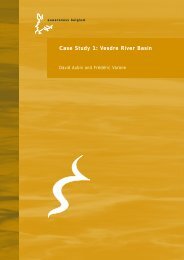Case Study 1: Matarraña River Basin - Euwareness
Case Study 1: Matarraña River Basin - Euwareness
Case Study 1: Matarraña River Basin - Euwareness
You also want an ePaper? Increase the reach of your titles
YUMPU automatically turns print PDFs into web optimized ePapers that Google loves.
of the affected by the expropriations for the pumping project. The association also<br />
looked for additional support among other municipalities within the basin and the<br />
Mancommunity of Municipalities of the <strong>Matarraña</strong> river basin. It also asked the Superior<br />
Court of Aragon to block of the project.<br />
The conflict by this time showed a confrontation between two coalitions of actors: those<br />
located at the higher basin and those located at the middle-lower basin. Whereas the<br />
irrigation communities and municipalities at the lower basin insisted in the need for<br />
water in order to save their crops, irrigation communities, neighbours and<br />
environmental groups at the higher basin were opposed to the projects for its<br />
environmental negative impacts and its inefficiency in covering the water demands.<br />
Actors located at the higher river basin managed to mobilise actors against the project<br />
and issued several reports against it. Some studies reveal several technical problems<br />
associated to the pumping project. Firstly, the limitations upon the quantity of water<br />
which could be pumped out —the maximum pumping flow (0.75 m 3 /s), the real flow of<br />
the river and the ecological flow— led to the practical impossibility of pumping the 2<br />
hm 3 per year flow that was planned. The reason for that is that when the Pena river —<br />
which feeds the Pena dam— has no water, neither has the <strong>Matarraña</strong>. As a result,<br />
during the last 3 irrigation seasons, even without respecting the established pumping<br />
period (from November to March), only 0.90 hm 3 have been pumped up to the Pena<br />
dam. Secondly, the Major Irrigation Ditch of the municipality of Valderrobres has a<br />
water concession of 0,624 m 3 /s between the pumps and the Pena mouth. This<br />
concession, which is destined to irrigation, population supply and industrial uses from<br />
1953, cannot be granted if the ecological flow is to be respected. In this sense the<br />
pumping conditions represent an important restriction in the flow conceded to this<br />
historic use right, which could only use 0.29 m 3 /s downstream. Thirdly, a study<br />
published in 1997 estimates a final pumping efficiency of 32%. Such estimation<br />
considers a 20% loss due to evaporation and filtration phenomena, a 20% loss in water<br />
transport from the Pena dam to the irrigation systems and also takes into account an<br />
efficiency of 80% of the pumping system and the 70% efficiency of the irrigation<br />
systems. And inally, the pumping project presents a negative cost-benefit analysis. The<br />
same study calculates that benefits in agriculture produced by each m 3 are about 5<br />
pesetas whereas the cost of the infrastructures and the costs of its functioning where<br />
about 38 pesetas per m 3 . In addition to that, as some reports point out, the main<br />
environmental impacts of the project include (Sostoa, 1996):<br />
50



